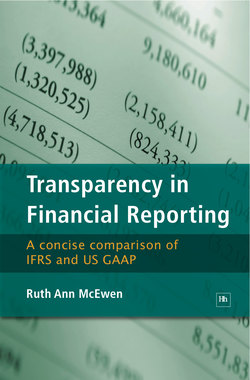Читать книгу Transparency in Financial Reporting - Ruth Ann McEwen - Страница 6
На сайте Литреса книга снята с продажи.
1. Transparency and Financial Reporting Quality
ОглавлениеTransparency may be viewed as a financial reporting quality indicator. While a single definition of financial reporting quality does not exist, markets have described a similar construct: earnings quality. Some view higher quality earnings as being more ‘persistent.’ [1] Others suggest current earnings quality should be defined for shareholders who rely on financial reports to buy future earnings. [2] All definitions seem to extend the idea that higher quality earnings are those that enable higher quality decisions about the future prospects for an entity. [3] Market based definitions of earnings quality relate higher quality to the ability of a firm to generate cash [4] or to be useful in predicting the future, as summarized in the following quote published in the CPA Journal in 2005:
Earnings quality refers to the ability of reported earnings to reflect the company’s true earnings, as well as the usefulness of reported earnings to predict future earnings. Earnings quality also refers to the stability, persistence, and lack of variability in reported earnings. [5]
High-quality earnings can be characterized as ‘repeatable, controllable and bankable.’ [6] In general, ‘taken as a whole, the quality of earnings can generally be summarized as the degree to which earnings are cash or non-cash, recurring or nonrecurring, and based on precise measurement or estimates that are subject to change.’ [7] Alternately, diminished earnings quality has been described as, ‘the extent to which net income reported on the income statement differs from true earnings.’ [8]
Note that some definitions seemingly conflict with others. Predictable earnings may be useful in predicting future earnings streams, but may not reflect the underlying volatility of an entity’s transactions. For example, entities with seasonal earnings patterns may be more difficult to predict, but the quality of earnings may be quite high. Persistent or recurring earnings as a determinant of earnings quality seems to be straightforward, but upon deeper examination, persistence implies the potential for smoothing, which is in conflict with the idea of having current earnings reflect an entity’s true earnings.
Under US GAAP, the underlying objective of financial reporting is to provide information that is useful to decision makers, primarily investors, in predicting the future earnings and cash flows of an entity. For financial statements to be useful to decision makers they must be transparent and of high quality – in other words, they must be representationally faithful. [9] Higher quality financial reports exhibit a high degree of correspondence between what they measure and what they purport to measure. [10] The AICPA notes that true earnings quality underlies the relation between the economic substance of a transaction, and our ability to reflect the transaction using accounting rules that require substantive judgment in a world of increasingly complex rules and transactions. [11] Transparency represents the next layer of the financial reporting model. Transparent financial reports are clear, accurate reports that reflect the economic substance of transactions in a straightforward manner, even in times of great uncertainty.
1 Scott Richardson, “Earnings Quality and Short Sellers”, Accounting Horizons 17, Supplement (2003), pp. 49-61. [return to text]
2 Stephen H. Penman, “The Quality of Financial Statements: Perspectives from the Recent Stock Market Bubble”, Accounting Horizons 17, Supplement (2003), pp. 77-96. [return to text]
3 Katherine Schipper and Linda Vincent, “Earnings Quality”, Accounting Horizons 17, Supplement (2003), pp. 97-110. [return to text]
4 www.ratefinancials.com [return to text]
5 Jodi L. Bellovary, Don E. Giacomino, and Michael D. Akers, “Earnings Quality: It’s Time to Measure and Report”, www.nysscpa.org/cpajournal/2005/1105/essentials/p32.htm. [return to text]
6 www.investopedia.com/articles/02/103002.asp [return to text]
7 Deloitte & Touche, Quality of Earnings, 2002. [return to text]
8 Frank Hodge, “Investors’ Perceptions of Earnings Quality, Auditor Independence, and the Usefulness of Audited Financial Information”, Accounting Horizons 17, Supplement (2003), pp. 37-48. [return to text]
9 See Schipper and Vincent, “Earnings Quality”, Supplement, Accounting Horizons (2003), pp. 97-110 for a discussion of Earnings Quality. [return to text]
10 CON 2, ¶ 63. [return to text]
11 http://fmcenter.aicpa.org/Resources/Traditional/Quality+of+Earnings+Case+Study+Collection.htm [return to text]
